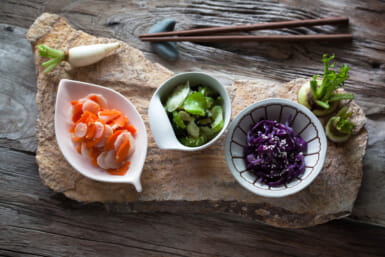with Donna Sweeny
Japanese Family Cooking
One of the cardinal principles of successful business is finding a need and then filling it — Hideko Sakurai has done just that. While she was conducting orientation tours for newly arrived women in Tokyo, she listened carefully to their questions, comments and problems. Mrs. Sakurai soon realized that most of the women she talked to had the same concerns: namely, how to feed their families economically and nutritiously while living in Tokyo.
She and her friend Noriko Araki began a unique cooking school that teaches foreigners where and how to shop for and cook, easily and economically, the many marvelous dishes of Japan. Mrs. Sakurai and Mrs. Araki are no slaves to routine; indeed, flexibility is the keynote of their basic operation. They are willing, for example, to conduct classes at their homes or those of their students, and although classes usually begin at 10 a.m., other times can be arranged to suit the individual needs of the students.
Originality is yet another positive attribute of their new endeavor. While basic, traditional Japanese cooking methods are covered, students also learn how to make use of ready-made, prepared foods and time-saving techniques. Seasonal vegetables and fish are emphasized, but students also learn acceptable alternatives which they can find in their home countries. Mrs. Sakurai and Mrs. Araki explain correct Japanese table manners as well as the historical and cultural background of the dishes they create.
Did you know, for example, that the perennial favorite, tonkatsu is actually an adaptation of wienerschnitzel, introduced by the German community in the 1860s? After each class, students are given obento to take home, a small sample of the foods they have learned to cook; in this way, they can share their new discoveries with their family right away. Also, a field trip to Tsukiji is used to show the students how to pick out fish and buy needed cooking equipment.
All in all, this looks like a unique and appealing opportunity for Tokyoites to have a true orientation to some real Japanese home cooking. For more information, call Hideko Sakurai at 268-3336 or Noriko Araki at 441-1331.
Here is a sampling of their recipes:
Miso Soup with Tofu (serves 4)
Dashi broth is basic to Japanese cooking. It lends its distinctive flavor to rice, soups, vegetables and salad dressings. Once prepared, it may be kept refrigerated for 2-3 days.
Dashi:
- 10 centimeters dried kelp (kombu)
- 3/4 cup dried bonito flakes (katsuobushi)
- 4 1/2 cups water
- Soak dried kelp in cold water for 30 minutes.
- Heat the water and kelp to a boil. Just before the simmering point, remove the kelp from the water and add the bonito flakes. As soon as the water starts to simmer, turn off the heat and wait until the flakes have settled.
- Strain through a sieve and use as required.
Miso Soup:
- 4 cups dashi
- 3-4 teaspoons miso (soy bean paste)
- 1/2 block tofu, cut into 1 centimeter cubes (kinugoshi, “silk tofu” is best.)
- 1/2 Japanese leek (negi), sliced thin
- Bring dashi to a boil. Mix some of the hot liquid with miso in a bowl, stirring until smooth. Pour the mixture into the dashi and stir well.
- Add tofu to the broth and just before the simmering point, turn off the heat.
- Sprinkle thinly sliced Japanese leeks into the soup and cover for one minute. Serve hot.
Tonkatsu (Pork Cutlet) (serves 4)
- Pork tenderloin or fillet, about 120 grams (4 ounces) for each person
- Salt and pepper to taste
- Light wheat flour (all purpose flour)
- 1 egg, beaten
- Bread crumbs
- Vegetable oil for deep frying
- Cabbage leaves, shredded
- Prepared mustard
- Worcestershire sauce or tonkatsu sauce
- Salt and pepper the pork.
- Coat the pork thinly with flour, dip in beaten egg and then in bread crumbs, pressing them in firmly. (This can be prepared 3-5 hours ahead of time and kept in the refrigerator.)
- Heat the oil in a large, heavy frying pan and fry the pork over medium heat until golden brown on both sides.
- Drain on a wire rack or on absorbent paper.
- Arrange the pork and shredded cabbage on individual plates. Serve with mustard and Worcestershire sauce or tonkatsu sauce.
Rice (serves 4)
- 1 cup dry rice
- 1 1/5 cups water*
- Rinse the rice under running water, mixing gently until the water is clear.
- Soak the rice and 1 1/5 cups water in a pot for 30 minutes to 1 hour.
- Cover the pot and heat the rice to a boil over high heat. The lid may bounce from the pressure of the steam, but allow the bubbles to overflow under the lid.
- When bubbles stop, reduce heat and keep boiling for 15 minutes. Turn off the heat and let the rice stand for 15 minutes.
- Mix the rice lightly with a wet wooden spatula to make the rice fluffy. Let it stand 5 more minutes with a dried dishcloth under the lid to remove excess moisture from the rice.
* Newly harvested rice requires a little less water, and old rice requires a bit more.
Horenso Goma-ae (Spinach with Sesame Dressing) (serves 4)
- 1-2 bundles of spinach
- 5 tablespoons raostcd white sesame seeds
- 1 1/2 tablespoons sugar
- 2 1/2 tablespoons soy sauce
- 1 tablespoon sake or dry sherry
- Cook the spinach in a large pot of salted water for 5 minutes. Rinse under cold running water. Gently squeeze and dry. Cut the spinach into 3-centimeter lengths (about 1 inch).
- Lightly crush the sesame seeds using a blender or mortar and pestle. Mix with sugar, soy sauce and sake.
- Arrange the spinach on individual salad plates; spoon the dressing over (he spinach. Serve at room temperature.
Mushroom & Seaweed Salad (serves 4)
Salad:
- 10 grams (1/3 ounce) dried wakame or 40 grams (1 1/3 ounces) fresh wakame
- Enokidake or shimeji or nama–shiitake mushrooms
- 1 head romaine lettuce
- 1 package kaiware
- 1 small asatsuki (Japanese leek), sliced thin
- 2 tablespoons roasted white sesame seeds
Dressing:
- 4 tablespoons rice vinegar
- 1 tablespoon sugar
- 1 tablespoon water
- 1/2 teaspoon soy sauce
- 1/2 teaspoon salt
- If using dried wakame, soften it in cold water for 3-5 minutes; remove the thick spine.
- If using enokidake or shimeji, cut the stems and divide them into small pieces by hand. If using nama-shiitake, cut them into thin slices.
- Plunge the mushrooms into boiling water for 1-2 minutes. Drain and cool.
- Cut the softened wakame into bite-size pieces; plunge the wakame into boiling water for 1 minute. Drain and cool.
- Mix the vinegar, sugar, water, soy sauce and salt and set aside.
- Place washed lettuce leave on individual salad plates; arrange the mushrooms and seaweed on top.
- Just before serving, pour the dressing over the salad and sprinkle the sesame seeds on top.








